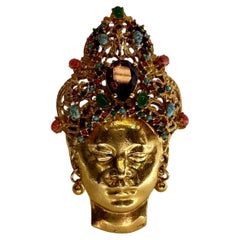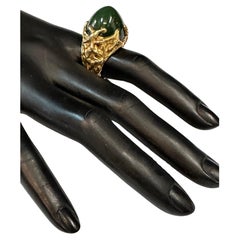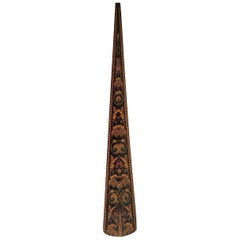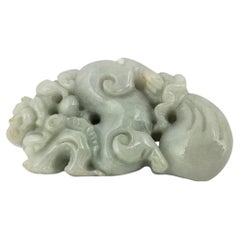G. None Collectibles and Curiosities
to
2
2
2
2
1
2
1
1
1
1
2
2
2
2
2
3
104
100
79
76
Creator: G. None
Rare Carlyle Co., “Emile Monier” Brooch Pin
By G. None
Located in Bronx, NY
This rare brooch pin is designed by Emile Monier for the Carlyle Co. . The oversize gold tone sculpted “statement” brooch is of an exotic, stunning Siames...
Category
Mid-20th Century American G. None Collectibles and Curiosities
Materials
Metal
Jade 18K Gold Ring
By G. None
Located in Bronx, NY
This impressive 18K gold & jade ring was designed & custom made by Merrin jewelers of New York in the 1960’s. It features a spectacular sculpted setting with a huge solid domed dark ...
Category
1960s American Vintage G. None Collectibles and Curiosities
Materials
Jade, Gold
$2,700
Related Items
Rare 19th Century English Tunbridgeware Hair Pin or Slide
Located in Dallas, TX
PRESENTING an EXTREMELY UNIQUE and RARE 19C British Tunbridgeware Hair Pin/Bobbin or Slide.
This slide is unlike any of it’s kind we have seen before, it is a VERY RARE survivor.
From circa 1860 – 80 and made in Tunbridge Wells, England.
Made of walnut with gorgeous marquetry inlay on the entirety of the front with classic Tunbridgeware micro-mosaic all over the front. The rear is walnut.
The marquetry inlay appears to be various different woods, namely, maple, walnut and satinwood.
Would have been worn in a Lady’s hair bun with the micro-mosaic facing forward.
This would have belonged to a VERY ELEGANT LADY in the mid to late 19th Century.
Tunbridge ware is a form of decoratively inlaid woodwork, typically in the form of boxes, that is characteristic of Tonbridge and the spa town of Royal Tunbridge Wells in Kent in the 18th and 19th centuries. The decoration typically consists of a mosaic of many very small pieces of different coloured woods that form a pictorial vignette. Shaped rods and slivers of wood were first carefully glued together, then cut into many thin slices of identical pictorial veneer with a fine saw. Elaborately striped and feathered bandings for framing were pre-formed in a similar fashion.
There is a collection of Tunbridge ware in the Tunbridge Wells Museum and Art Gallery in Tunbridge Wells.
The famous makers of Tunbridge ware were in the Tunbridge Wells area of Kent; their most notable work was from circa 1830-1900.
Early makers of Tunbridge ware, in Tunbridge Wells in the mid-18th century, were the Burrows family, and Fenner and Co. In the 19th century, around 1830, James Burrows invented a technique of creating mosaics from wooden tesserae. Henry Hollamby, apprenticed to the Burrows family, set up on his own in 1842 and became an important manufacturer of Tunbridge ware, employing about 40 people.
Edmund Nye (1797–1863) and his father took over the Fenner company when William Fenner retired in 1840, after 30 years in partnership with him. Thomas Barton (1819–1903), previously apprenticed at the Wise factory, joined the Nyes in 1836, and worked as Nye’s designer; he took over the business in 1863 and continued there until his death.
In Tonbridge (near to Tunbridge Wells), George Wise (1703–1779) is known to have had a business in 1746. It continued with his son Thomas, and Thomas’s nephew George (1779–1869), who took over in 1806. In its early years the company made articles such as workboxes and tea caddies with prints of popular views; later items had pictures created from mosaics. Their workshop in Tonbridge, Wise’s Tunbridge Ware Manufactory, was next to the Big Bridge over the Medway; the building was demolished in 1886 to widen the approach to the bridge.
Tunbridge ware became popular with visitors to the spa town of Tunbridge Wells, who bought them as souvenirs and gifts. Articles included cribbage boards, paperweights, writing slopes, snuffboxes and glove boxes.
At the Great Exhibition of 1851, Tunbridge ware by Edmund Nye, Robert Russell and Henry Hollamby was shown; Edmund Nye received a commendation from the judges for his work. He exhibited a table depicting a mosaic of a ship at sea; 110,800 tesserae were used in making the picture.
The manufacturers of Tunbridge ware were cottage industries, and they were no more than nine in Tunbridge Wells and one in Tonbridge. The number declined in the 1880s; competent craftsmen were hard to find, and public tastes changed. After the death of Thomas Barton in 1903 the only surviving firm was Boyce, Brown and Kemp, which closed in 1927.
Marquetry was an old technique which was continued by Nye and Barton to create images such as birds or butterflies.
‘Green Oak’ as caused by the fungus Chlorociboria aeruginascens.
Stickware and half-square mosaic was invented by James Burrows in about 1830: a bunch of wooden sticks of different colours, each having triangular or diamond-shaped cross section, were tightly glued together; in the case of stickware, the resulting block was dried, then turned to form an article such as the base of a pincushion. For half-square mosaic, thin slices were taken from the composite block, and applied to a surface.
Tesselated mosaic, was a development by James Burrows of half-square mosaic; it was adopted by George Wise and Edmund Nye. Minute tesserae were used to form a wide variety of geometric and pictorial designs.
Many sorts of wood were used for the various colours; about 40 were in regular use. Only natural colors were used; green was provided by “green oak”, produced by the action of fungus on fallen oak. Designs for articles were often taken from designs of Berlin wool work.
Category
Late 19th Century English High Victorian Antique G. None Collectibles and Curiosities
Materials
Satinwood, Walnut
Chinese Jade Pendant
Located in Hamilton, Ontario
Nicely carved Jade pendant. Weight: 29.13 grams.
Jewelry / Necklace.
Category
1970s Chinese Vintage G. None Collectibles and Curiosities
Materials
Jade
Substantial Estate 18k Gold Greek Open-Link Bracelet
Located in Shippensburg, PA
A SUBSTANTIAL ESTATE 18K GREEK FLORENTINE OPEN-LINK BRACELET
With enamel spacer links and diamond accents; 8 1/4" long, 85.2 grams
Item # C104203
An incredibly fine statement piece ...
Category
20th Century Greek G. None Collectibles and Curiosities
Materials
Gold, Enamel
Vintage 18K Carved Rock Crystal, Jade and Diamond Lily of the Valley Clip Brooch
Located in Norwood, NJ
A lovely 18K yellow gold vintage floral brooch realistically modeled as lily of the valley, set with frosted carved rock crystal flowers, each suspending a sparkling full round cut diamond, mounted on an 18k yellow gold stem and a carved jade leaf...
Category
Early 20th Century Austrian G. None Collectibles and Curiosities
Materials
Jade, Rock Crystal, Gold
$2,875
H 2.27 in W 0.83 in D 0.79 in
Vintage Sterling Silver Horses Brooch/Pin, stamped Beau Sterling
Located in Warrenton, OR
Vintage Sterling Silver Horses Brooch/Pin, stamped Beau Sterling
This is a Beau Sterling running horses brooch, a parent and youth horse pair.
IMPORTANT INFORMATION FOLLOWS; PLEASE ...
Category
Mid-20th Century Unknown Mid-Century Modern G. None Collectibles and Curiosities
Materials
Sterling Silver
$120 Sale Price
20% Off
H 1 in W 1.5 in D 0.2 in
18K Gold Diamond And Emerald Snake Serpent Wrap Ring
Located in Norwood, NJ
18K yellow gold, emerald and diamond statement ring in the form of a serpent/snake with ruby eyes. Stylishly designed to wrap around your finger and display the elegant form of gold ...
Category
20th Century Italian G. None Collectibles and Curiosities
Materials
Multi-gemstone, Gold
Sterling Silver Brooch/Pin, stamped Beau Sterling
Located in Warrenton, OR
Sterling Silver Brooch/Pin, stamped Beau Sterling
This Beau Sterling leaf motif brooch is about 3" long and curves slightly away from the underside. As shown in the photos, it has n...
Category
Mid-20th Century Unknown Brutalist G. None Collectibles and Curiosities
Materials
Sterling Silver
Burmese Jade Pendant
Located in Hamilton, Ontario
A thick jade pendant carved from Burmese Jade. It features a beautiful range of colors including icy-yellow, apple-green and pale-green jade. Weight: 34.20 ...
Category
1970s Burmese Vintage G. None Collectibles and Curiosities
Materials
Jade
Jade And Rose Quartz 18K Floral Form Brooch
Located in Norwood, NJ
Jade and rose quartz 18K yellow gold floral form brooch pin. Pearls and diamonds with carved rose quartz pedals and jade leaves.
The delicate blossom of this brooch is crafted from ...
Category
20th Century Austrian G. None Collectibles and Curiosities
Materials
Jade, Gold
Petite Vintage Micro Mosaic Pin Brooch Flowers Millefiori, Venice Italy
Located in Nuernberg, DE
A gorgeous petite micro mosaic jewelry. No restoration has been carried out on this charming little piece, which remains in very stabile and funct...
Category
1930s Italian Vintage G. None Collectibles and Curiosities
Materials
Metal
$120
H 1.13 in W 1.75 in D 0.38 in
Jade And Coral 14K Gold Strawberry Branch Pin Brooch
Located in Norwood, NJ
This vintage brooch represents a branch of a strawberry plant with engraved jade leaves. The vines are from 14k yellow gold and the strawberries are of carved coral. Carved crystal f...
Category
20th Century Austrian G. None Collectibles and Curiosities
Materials
Coral, Jade, Gold
Jade, Amethyst And Diamond 14K Gold Form Brooch Pin
Located in Norwood, NJ
14k yellow gold brooch in the form of a floral grouping. Set with amethyst flowers, jade leaves and single cut diamonds. Marked 585 with makers mark.
Weight 16.4g.
Category
20th Century Italian G. None Collectibles and Curiosities
Materials
Amethyst, Jade, Gold
G. None collectibles and curiosities for sale on 1stDibs.
G. None collectibles and curiosities are available for sale on 1stDibs. These distinctive items are frequently made of stone and are designed with extraordinary care. If you’re looking for additional options, many customers also consider collectibles and curiosities by Charles Hollis Jones, Tiffany & Co., and Christo and Jeanne-Claude. Prices for G. None collectibles and curiosities can differ depending upon size, time period and other attributes — on 1stDibs, these items begin at $4,000 and can go as high as $4,000, while a piece like these, on average, fetch $4,000.



